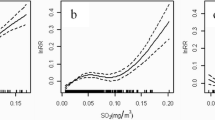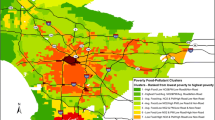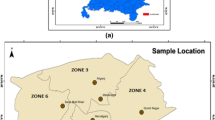Abstract
Most of the models developed to study the effects of pollutants on the health of people are single input and single outcome while adjusting for other variables. However, the real environment is a mixture of pollutants, which affect people synergistically and varies in time and space. The aim of this work is to introduce a multiple exposures-outcomes tree regression method. An oblique tree with Weighted Oblique Decision Trees (WODT) algorithm was designed to find the share effects of pollutant(s) on health outcomes and investigate the temporal and spatial differences. Using this method, a case study was conducted on the association between O3, NO2, PM2.5 and asthma, COPD, pneumonia, and bronchitis in CA, USA. The results indicated that NO2 and O3 are responsible for asthma emergency department (ED) visits in South Coast and San Diego Air Basins during January–April and October–December for the years 2005–2015. For PM2.5, the results indicated that an increase in concentration was associated with an increase in the number of ED visits for COPD and pneumonia during January–December in the whole study area. The method introduced in this study is useful in handling multi-pollutant exposure conditions. Using this method, public health agencies and policy makers can better understand the relative effects of multiple pollutants on the health of people in temporal and spatial scales.






Similar content being viewed by others
References
Alhanti BA, Chang HH, Winquist A, Mulholland JA, Darrow LA, Sarnat SE (2016) Ambient air pollution and emergency department visits for asthma: a multi-city assessment of effect modification by age. J Expo Sci Environ Epidemiol 26:180–188
Billionnet C, Sherrill D, Annesi-Maesano I (2012) Estimating the health effects of exposure to multi-pollutant mixture. Ann Epidemiol 22:2
Brauer M, Tamburic L (2009) Multi-pollutant analysis of reproductive outcomes and air pollution using the CMAQ model. Epidemiology 20:S72–S73
Breiman L (2001) Random forests. Mach Learn 45:5–32
Breiman LJ, Friedman JH, Olshen RA et al (1984) Classification and regression trees. Wadsworth, Belmont
Criminisi A, Shotton J (2013) Decision forests for computer vision and medical image analysis. Springer-Verlag, Advances in Computer Vision and Pattern Recognition
De'Ath G (2002) Multivariate regression trees: a new technique for modeling species–environment relationships. Ecology 83(4):1105–1117
Dominici F, Peng RD, Barr CD, Bell ML (2010) Protecting human health from air pollution: shifting from a single-pollutant to a multi-pollutant approach. Epidemiology 21(2):187–194
Entwistle MR, Gharibi H, Tavallali P, Cisneros R, Schweizer D, Brown P, Ha S (2019) Ozone pollution and asthma emergency department visits in Fresno, CA, USA, during the warm season (June–September) of the years 2005 to 2015: a time-stratified case-crossover analysis. Air Qual Atmos Health 12:661–672
Felix JD, Eliot EM (2014) Isotopic composition of passively collected nitrogen dioxide emissions: vehicle, soil and livestock source signatures. Atmos Environ 359–366
Gharibi H, Entwistle MR, Ha S et al (2018) Ozone pollution and asthma emergency department visits in the Central Valley, California, USA, during June to September of 2015: a time stratified case-crossover analysis. J Asthma 0:1–9
Gouveia N, Bremner SA, Novaes HMD (2004) Association between ambient air pollution and birth weight in São Paulo, Brazil. J Epidemiol Community Health 58:11–17
Jaeglé L, Steinberger L, Martin RV, Chance K (2005) Global partitioning of NOx sources using satellite observations: relative roles of fossil fuel combustion, biomass burning and soil emissions. Faraday Discuss 130:407–423
Lin M, Chen Y, Burnett RT et al (2003) Effect of short-term exposure to gaseous pollution on asthma hospitalisation in children: a bi-directional case-crossover analysis. J Epidemiol Community Health 57(1):50–55
Malig BJ, Pearson DL, Chang YB, Broadwin R, Basu R, Green RS, Ostro B (2016) A time-stratified case-crossover study of ambient ozone exposure and emergency department visits for specific respiratory diagnoses in California (2005–2008). Environ Health Perspect 124(6):745–753
Mauderly JL, Burnett RT, Castillejos M, Özkaynak H, Samet JM, Stieb DM, Vedal S, Wyzga RE (2010) Is the air pollution health research community prepared to support a multipollutant air quality management framework? Inhal Toxicol 22(Suppl 1):1–19
Molitor J, Coker E, Jerrett M, Ritz B, Li A (2016) Part 3. Modeling of multipollutant profiles and spatially varying health effects with applications to indicators of adverse birth outcomes. In: development of statistical methods for multipollutant research. Research Report 183. Boston: Health Effects Institute
National Research Council. (2004) Committee on Air Quality Management in the United States. Air Quality Management in the United States. Washington: National Academies Pressn.d.
Pekkanen J, Pearce N (2001) Environmental epidemiology: challenges and opportunities. Environ Health Perspect 109:1
Quinlan JR (1986) Induction of decision trees. Mach Learn 1(1):81–106
Quinlan JR (1992) C4.5 programs for machine learning. Morgan Kaufmann Publishers, San Mateo
Ritz B, Wilhelm M (2008) Ambient air pollution and adverse birth outcomes: methodologic issues in an emerging field. Basic Clin Pharmacol Toxicol 102:182–190
Rokach L, Maimon O (2005) Top-down induction of decision trees classifiers—a survey. IEEE Trans Syst Man Cybern C Appl Rev 354
Sowlat MH, Gharibi H, Yunesian M, Tayefeh Mahmoudi M, Lotfi S (2011) A novel, fuzzy-based air quality index (FAQI) for air quality assessment. Atmos Environ 45(12):2050–2059
Sunyer J, Anto JM, Murillo C et al (1991) Effects of urban pollution on emergency room admissions for chronic obstructive pulmonary disease. Am J Epidemiol 134:277–289
Susser M, Susser E (1996a) Choosing a future for epidemiology: I. eras and paradigms. Am J Public Health 86:668–673
Susser M, Susser E (1996b) Choosing a future for epidemiology: II. From black box to Chinese boxes and eco-epidemiology. Am J Public Health 86:674–677
Trevor H, Robert T, Friedman J (2009) The elements of statistical learning: data mining, inference, and prediction, 2nd edn. Springer, New York
US Environmental Protection Agency. (2019) Air Quality System Data Mart (internet database) available at http://www.epa.gov/ttn/airs/aqsdatamart. Accessed 07/19/2019
Vedal S, Kaufman JD (2011) What does multi-pollutant air pollution research mean? Am J Respir Crit Care Med 183:4–6
Vedal S, Brauer M, White R, Petkau J (2003) Air pollution and daily mortality in a city with low levels of pollution. Environ Health Perspect 111:45–52
Wilhelm M, Ghosh JK, Su J, Cockburn M, Jerrett M, Ritz B (2011) Traffic-related air toxics and preterm birth: a population-based case-control study in Los Angeles County, California. Environ Health 10:89
Yang BB, Shen SQ, Gao W (2019) Weighted oblique decision trees. The Thirty-Third AAAI Conference on Artificial Intelligence (AAAI-19)
Acknowledgments
We would like to thank Bin-Bin Yang (National Key Laboratory for Novel Software Technology at Nanjing University, Nanjing, 210023, China) who shared his algorithm codes from “Weighted Oblique Decision Trees” manuscript with us. We would also like to thank the California’s Office of Statewide Health Planning and Development (OSHPD) for providing us with the data, and those who helped us conducting this research.
Availability of data and material
The data is available upon request.
Code availability
The codes are available upon request.
Author information
Authors and Affiliations
Corresponding author
Ethics declarations
Conflict of interest
The authors declare that they have no conflict of interest.
Additional information
Publisher’s note
Springer Nature remains neutral with regard to jurisdictional claims in published maps and institutional affiliations.
Rights and permissions
About this article
Cite this article
Tavallali, P., Gharibi, H., Singhal, M. et al. A multi-pollutant model: a method suitable for studying complex relationships in environmental epidemiology. Air Qual Atmos Health 13, 645–657 (2020). https://doi.org/10.1007/s11869-020-00829-3
Received:
Accepted:
Published:
Issue Date:
DOI: https://doi.org/10.1007/s11869-020-00829-3




